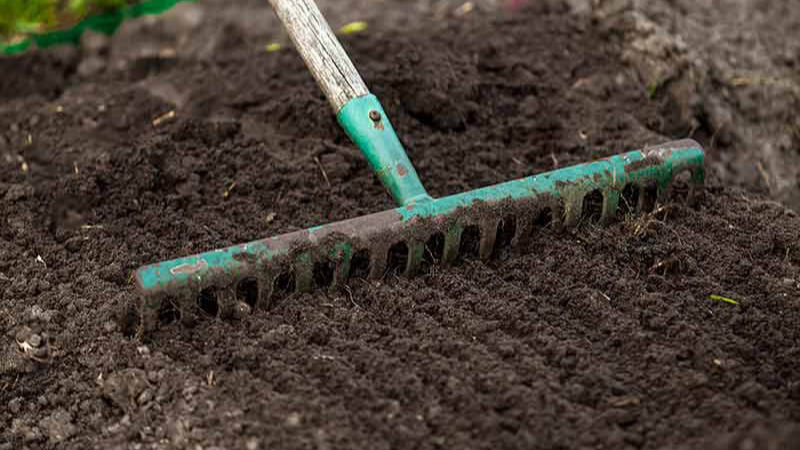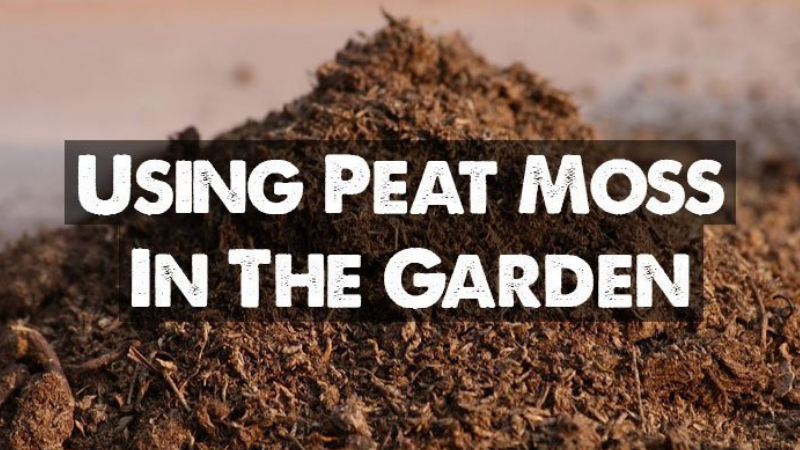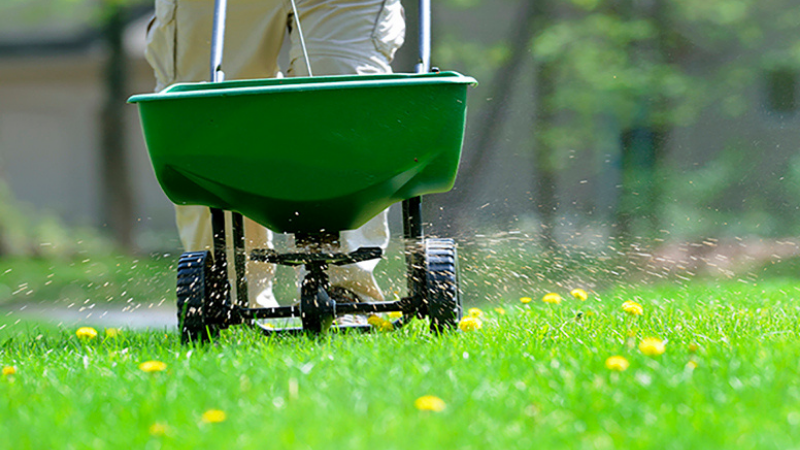How To Mix Grass Seed and Fertilizer Simultaneously? Step By Step Guide
by Lee Safin
Everyone wants to keep their lawn fresh and beautiful with perfect shape and height. What method do you follow to take care of your lawn? Though lawns always grow, reseeding is required when the winter season passes.
So, the burning question is, How to mix grass seed and fertilizer simultaneously?
To mix grass seed and fertilizer simultaneously you have to apply the particular herbicide. Then mix the grass seed and fertilizer properly with an adequate amount of water.
With the right type of fertilizer, you can ensure healthy growth for your lawn. Mixing grass seed and fertilizer at a time will make a good combination. It will ensure root growth and make them perfect. You will notice your lawn is having a boost of energy after applying the fertilizer.
In this article, we will tell you how to mix grass seed and fertilizer simultaneously step-by-step. By following the method, you can achieve great lawn growth. Let’s begin!
Contents

How To Mix Grass Seed And Fertilizer Simultaneously? Step By Step

Before knowing how to mix grass seed and fertilizer simultaneously, it is important to know which type of fertilizer you should use for your lawn.
According to most experts, granular fertilizers are most effective for lawns, especially when mixed with grass seed.
This type of fertilizer releases nutrition to the soil slowly. As a result, the lawn receives all essential nutrients for a prolonged time, especially during the growing season.
In addition, the mixture will multiply the growth of the lawn quickly. Once the germination is completed, the grass seed will have a great deal of energy. Due to the powerful formula, you will also notice unwanted weed growth on your lawn.
Here we are mentioning the effective method on how to mix grass seed and fertilizer simultaneously so that you can achieve a beautiful lawn.
Step 1 — Testing The Soil

As for the first step of how to mix grass seed and fertilizer simultaneously, you want to test the soil of your lawn. For that, taking the soil from various spots is essential. Don’t forget to take soil from the reseeding area too.
Give the soil to the Department of Agricultural Extension of your nearby location to test your soil quality. Having your soil tested helps you know the current condition of your soil, increase your lawn growth, and what type of problem your soil has.


The institution may take 4-6 weeks to test the soil and report the result. The libratory will suggest the fertilizer that will be best for your lawn, and they will mention the soil’s pH level.
Step 2 — Applying A Particular Herbicide


It is common to see weeds grow for most lawns. Weeds come in various types. So, you want to apply a particular herbicide based on the kind of weed your yard has.
Often, several kinds of weeds are seen on the lawn. In that case, you want to apply an effective herbicide to kill all of them.
Step 3 — Preparing The Reseeding Area

Now, use a garden rake to clean off the dead thatch stuff and other clods of dirt. The garden rake will also level and grade the soil before you finally apply the fertilizer. Besides, it will ensure proper airflow for the soil.
Before finally applying the mixture, you want to remove the thatch stuff from the soil and keep it aside to a compost pile. However, since it is an organic material, you can add the compost at year-end.
Step 4 — Mixing Grass Seed And Fertilizer

You might have already learned how much fertilizer you need to apply as per the agricultural extension recommendation.
So, how much grass seed do you need to use?
It depends on your soil quality, grass seed quality, and how thick lawn you want to achieve. According to most experts, the ideal grass seeding per 1,000 square feet is 1 to 2 pounds.
Then, you want to mix the recommended ratio of fertilizer with grass seed. Take a big bucket or container to mix both ingredients evenly.
Step 5 — Applying The Mixture

Wondering about this question: how do you apply grass seed and fertilizer? So, you have already mixed both ingredients properly. Now, you want to use them on the lawn area where you want to regrow grass.


Avoid applying too much mixture to a particular area. Make sure you spread the mix of grass and fertilizer evenly in all places for the healthy growth of the lawn.
You can use a seed broadcaster to spread the mixture quickly. It also prevents excessive thinning issues.
Read More – Which One Is The Best Lawn Spreader for Seeds and Fertiliser?
Step 6 — Water The Area

Spreading the mixture is done. Next, you need to apply water to the soil where you use the mixture.
You can use a sprinkler and garden hose to spray the lawn in a controlled manner. Applying water per week is necessary, and the water should reach 1 to 2 inches of soil. However, it can be more or less based on the rainfall of your particular area.
When the lawn reaches 3.5 or 4 inches in height, mow them with your lawnmower. You can cut up to 2.5 inches.


So, these are all the required steps you want to follow to know how to mix grass seed and fertilizer simultaneously step-by-step.
Note
Many garden experts don’t recommend using grass seed and fertilizer at a time because it may cause uneven distribution. At worst, it may burn a particular soil area due to excessive fertilizer. However, it doesn’t always happen. If you are not sure what to do, you can take help from a garden expert. Or, you can apply the fertilizer just before seeding the grass seed.
Do You Fertilize Or Put Grass Seed Down First?
You have already learned how to mix grass seed and fertilizer simultaneously. As we already mentioned, many gardeners don’t want to use them simultaneously. So, do you fertilize or put grass seed down first?
Growing lawn healthily is not an easy-peasy job as many people think. Some preparation is required to boost the growth of grass seeds. Ensuring seed germination is essential, which can only happen under proper conditions.
While wondering about “Do you fertilize or put grass seed down first?” you should know that a starter fertilizer is essential to increase juvenile growth.
However, you want to be cautious while applying the starter fertilizer. The reason is that the amount should be neither too much nor too little.
1. Applying Initial Fertilizer


It is necessary to apply initial fertilizer near the seed to ensure proper nutrition for the upcoming seedling.
You can scatter the grass seed and fertilizer individually. Following one after another is okay, so it merely matters which one you observe first. All that matters is applying one after another immediately.
Alternatively, you can also apply them at a time, which we have mentioned above (how to mix grass seed and fertilizer simultaneously). But as we already said, the mixture should be balanced, neither too much nor too little.
2. Fertilizing After Seeding


The germination process of grass seed will occur after applying the initial fertilizer. However, during the growing season of grass, they need a higher amount of nutrition. Plus, they absorb the nutrients from the soil quickly during the growing period.
As a result, applying second-time fertilizer is the best decision. You can either use the initial fertilizer or a particular grass fertilizer. If you use the initial fertilizer, the gap between the applications should be four weeks.
Once you use the fertilizer for the second time, you will notice how fast the grass grows. Make sure you followed the recommended fertilizer rate as per the kind of grass your lawn has.
When Is The Best Time To Sow Grass Seeds?

Aside from knowing how to mix grass seed and fertilizer simultaneously, do you know what the best time to sow grass seeds is?
How soon after a new grass seed can I fertilize? According to many garden experts, sowing grass seeds during the early fall will give you the best result. So why choose this specific time? The excessive heat of summer will already expire, but the soil will retain enough heat to ensure the germination of seeds.
But, when is the specific time according to the English calendar as countries’ seasons vary? As per most countries, it is between the end of August or the beginning of October.
It is the perfect time to sow seeds because the seed grass will have enough time on its hands to become fully grown up. Therefore, heavy cold during the winter won’t be able to harm it.
However, if you fail to provide the grass seed sufficient time to establish them, they may die. Alternatively, you can sow seeds during the spring season if you are not free in the early fall.
In that case, you want to make sure the seed becomes enough grown-up before the intense summer hits. Otherwise, the excessive heat will dry up the grass.
Weed-and-Feed Products
You may already have fertilizer and herbicide at home. But how about using a product that has both of these items? Using this combined formula will control or kill weeds while ensuring sufficient growth of grass.
This type of product is not permitted to use immediately after sowing the seeds. Why? Applying the product after sowing the seeds will stop or slow down the natural germination process of grass seed.
However, you can also use the product before sowing seeds. In that case, at least six weeks of gaps are required before you sow grass seeds finally.
On the other hand, if you want to use the product after sowing the seeds, you must wait around 6-8 weeks. The time frame is approximately four times of mowing session.
Organic Matter


Organic matter is mainly known as carbon-based compounds or soil amendments. It improves overall soil quality and fertility while supplying many necessary nutrients.
It also helps soil plants to cope up with various weather conditions easily. As a result, grass will grow healthily since it works as a reservoir of nutrients for the grass.
However, all organic matters are not made equally, so their working mechanism also varies. For instance, wood-based organic matters will stop your grass seed from receiving the right level of manure and nitrogen.
Lack of nitrogen will prevent the natural growth of your grass seed, and it will turn a yellow color. Grass seed growth will also slow down if it doesn’t receive enough manure.
Hopefully, you have got a clear view about “Do you fertilize or put grass seed down first?”
How To Take Care Of Newly Planted Grass Seeds?
Apart from knowing how to mix grass seed and fertilizer simultaneously, it is also necessary to understand how to take care of newly planted grass seed.
Step 1 —Using A Peat Moss

Covering the grass seeds with peat moss will provide multiple benefits. It will ensure proper soil aeration and help to retain essential nutrients more effectively.
Also, it will hold the perfect amount of soil moisture. Make sure the size of the peat moss ranges between ¼ to 1/8 inches.
Step 2 —Watering Grass Seeds

After setting up a peat moss, watering the seeds is necessary. Since the cover creates a thick layer, you want to water it a minimum of 6 inches.
Should you water heavily at a time? No! Waterlogging will occur. Instead, you will water it several times in a small quantity.
Give a small gap between watering to let the soil absorb the water. Checks out you don’t create any puddles while watering grass seeds.
Step 3 —Watering Routinely For 3 Weeks


Most experts believe it is important to water newly planted grass seeds at least two times every day. You should continue doing it regularly for three weeks without giving any gap.
So, when is the perfect time to water your lawn daily? It is best to water them very early morning or before sundown. As you need to water them two times, do it both times. Following it gives the soil enough time to absorb the water easily.
Step 4 —Watering Less Often
Once you notice the grass seeds are growing healthily, you should start watering less often. Reduce the watering frequency gradually.
For example, instead of watering two times a day, do it for one time. After that, keep one day’s break between watering. When they become fully grown-up, watering the lawn only once per week is enough.
Step 5 —Fertilizing The Lawn

Do you think your job is completed once the lawn becomes fully grown-up? No! Fertilization is essential for new grass regularly.
When the germination procedure exceeds six weeks, you want to fertile the new grass. Don’t forget to choose the right fertilizer based on your grass type. Also, you apply the fertilizer at the recommended rate without overdoing it.
Read More – Which One Is The Best Lawn Spreader for Seeds and Fertiliser?
Here we mention two types of grass categories and which fertilizer is the best based on their type.
| Cool-season Grasses | Bentgrasses, Ryegrasses, Fescues, Blue Grasses, Perennial Ryegrass, etc. | Traditional Lawn Winterization Fertilizer |
| Warm-Season Grasses | Zoysia Grass, St. Augustine Grass, Bermuda Grass, Bahia Grass, Centipede Grass, etc. | Slow Release Fertilizer |
Step 6 —Mowing The Lawn
As we already mentioned earlier, before mowing the new grass for the first time, let it grow for at least 3.5-4 inches. Use an efficient lawnmower with sharp blades to cut grass evenly and quickly.
Read More – What Are The Best Lawn Mowers For Small Yards?
Step 7 —Removing Weeds

Weeds build-up is a common scenario, especially for a new lawn. It is necessary to take off weeds from grass by using. Since they are newly grown, there won’t be many weeds. You can use your hands to remove them.
However, you need to wait. You want to mow the grass at least two times before removing weeds from the grass. After that, you can also use an organic herbicide is required.
Read More – How Do Herbicides Kill Weeds But Not Grass?
Is There a Grass Seed and Fertilizer Mix?
Are you wondering about this question: is there a grass seed and fertilizer mix? Yes, you will find few brands selling grass seed and fertilizer mix. One of them is Scotts® Turf Builder® Overseeding Mix Seed & Starting Fertilizer.
No products found.
No products found.
However, it may not work for your grass unless it is compatible with your grass type. But if it matches with your grass type, you may get effective within ten days.
We have gone through reviewers’ comments from Amazon. Some people got incredible results while some of them were not happily using the products. You will find many similar products from different online or offline stores.
However, it is better to verify whether the product will work for you by talking with a garden expert. If you don’t want to take any risks, we recommend buying grass seeds and fertilizer separately.
Since we have already mentioned how to mix grass seed and fertilizer simultaneously, you should have no issues combining them. Hopefully, you have learned precise details about “Is there a grass seed and fertilizer mix?”
Wrapping Up
Like other plants, grasses also need regular maintenance for proper growth. Proper care ensures healthy growth. Knowing how to mix grass seed and fertilizer simultaneously will help you provide the perfect grass growth. We have also mentioned how to take care of them properly from time to time. Make sure you follow them. Happy Gardening!
Last update on 2023-01-28 / Affiliate links / Images from Amazon Product Advertising API
 |
 |
 |
 |

About Lee Safin
Lee Safin was born near Sacramento, California on a prune growing farm. His parents were immigrants from Russia who had fled the Bolshevik Revolution. They were determined to give their children a better life than they had known. Education was the key for Lee and his siblings, so they could make their own way in the world. Lee attended five universities, where he studied plant sciences and soil technologies. He also has many years of experience in the U.S. Department of Agriculture as a commercial fertilizer formulator.
Thoughts on "How To Mix Grass Seed and Fertilizer Simultaneously? Step By Step Guide"
 |
 |
 |
 |
Get FREE Gardening Gifts now. Or latest free toolsets from our best collections.
Disable Ad block to get all the secrets. Once done, hit any button below
 |
 |
 |
 |